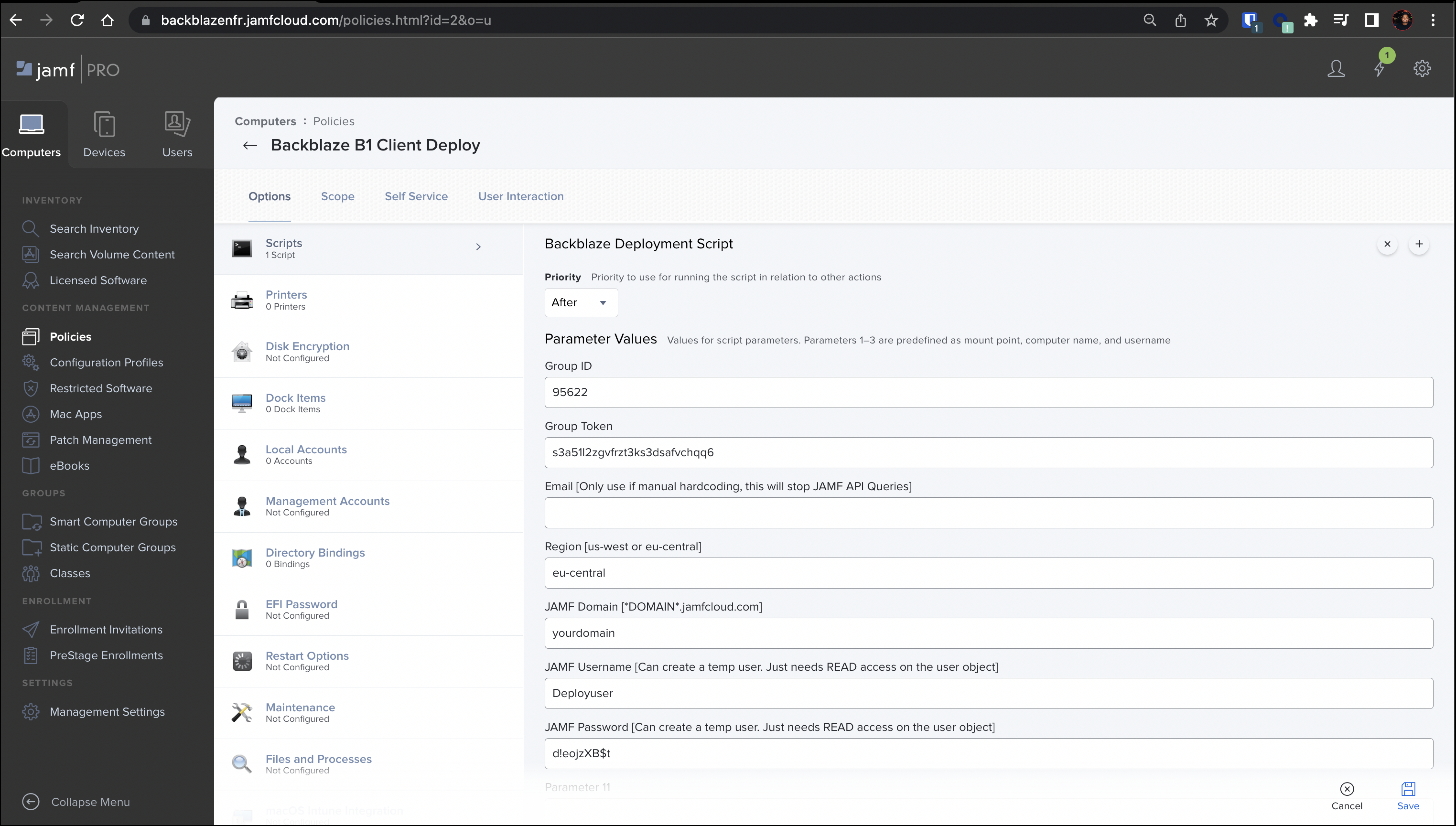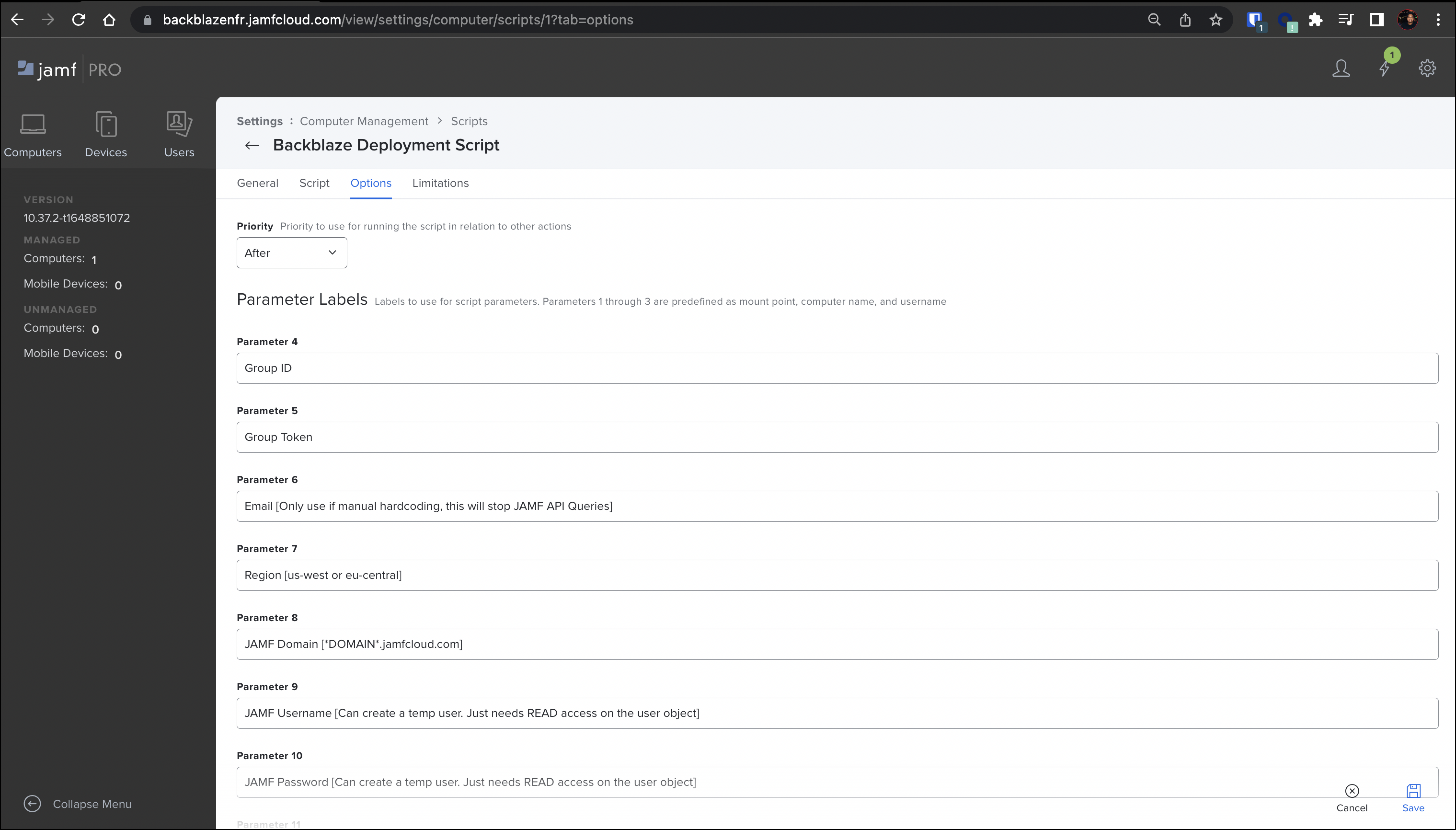- Print
- DarkLight
Install the Backblaze Client Silently with JAMF (Mac)
- Print
- DarkLight
For mac operating systems, pushing an application to hundreds of users generally involves a mountable .dmg file that contains an installer package. The Backblaze Computer Backup Installer for macOS works similarly, and you can use JAMF to deploy the client silently.
Use a Shell Script to Silently Deploy with Jamf
The shell script makes interfacing with commands easier. If you use the script, you can dynamically complete the following workflows:
- Automatically handle both new account deployments (-createaccount) and existing account deployments (-signin) without the need to dictate ahead of time per deployment.
- Upgrade deployments that already have the software installed and running.
- Handle Jamf Pro environments that need to use a decentralized deployment.
Click here to expand the macOS script.
#!/bin/bash
# All variables can be hardcoaded if not using using a JAMF policy, by default however it will pull from your policy parameters.
############### Backblaze Variables ###############
# The following parameters are pulled directly from the "Parameter Values" section of your Backblaze deployment policy.
# You can find these values in the advanced deployment section of your Backblaze group console.
# Please make sure they are filled out respectively prior to your push
group_id="$4"
group_token="$5"
email="$6" # If email is entered in parameters, script will skip over using JAMF API, make sure related password is entered as well
region="$7" # Specify if account is to be deployed in specific region [us-west or eu-central]
############### JAMF Variables ####################
# The script needs access to the JAMF Pro API to gather the related email for a given user
# Account just needs to have Users - Read permissions
# You can configure a temp account for this in the "Jamf Pro User Accounts & Groups" section of your console
computer_name="$2"
user_name="$3"
jamf_domain="$8"
jamf_user_name="$9"
jamf_password="${10}"
############### Script Variables ####################
bearer_token=""
email_retrieved_from_computer_name=false
############### BZERROR MEANINGS ###################
# BZERROR:190 - The System Preferences process is running on the computer. Close System Preferences and retry the installation.
# BZERROR:1000 - This is a general error code. One possible reason is that the Backblaze installer doesn't have root permissions and is failing. Please see the install log file for more details.
# BZERROR:1016/1003 - Login Error... Email account exists but is not a member of indicated Group, Group ID is incorrect, or Group token is incorrect,
################ FUNCTIONS #########################
function update_backblaze {
return=$(sudo /Volumes/Backblaze\ Installer/Backblaze\ Installer.app/Contents/MacOS/bzinstall_mate -upgrade bzdiy)
}
function sign_in_backblaze {
return=$(sudo /Volumes/Backblaze\ Installer/Backblaze\ Installer.app/Contents/MacOS/bzinstall_mate -nogui -createaccount_or_signinaccount "$email" "$group_id" "$group_token")
}
function create_region_account {
return=$(sudo /Volumes/Backblaze\ Installer/Backblaze\ Installer.app/Contents/MacOS/bzinstall_mate -nogui -createaccount_or_signinaccount "$email" "$group_id" "$group_token" "$region")
}
function email_validation {
[[ "$email" =~ ^[a-zA-Z0-9._%+-]+@[a-zA-Z0-9.-]+\.[a-zA-Z]{2,4}$ ]]
rc=$?
if [ "$rc" != "0" ]; then
if [ "$email_retrieved_from_computer_name" = true ]; then
echo "Failed to retrieve valid email address from JAMF API. Parsed Email: [ $email ]"
echo "Please make sure JAMF credentials have READ access on the user object and endpoints have emails properly set"
exit 1
else
echo "Failed to retrieve valid email address from JAMF API. Attempting to use computer name"
jamf_api_computer_name
fi
else
echo "The email retrieved from JAMF API [ $email ] seems to be a valid email address"
echo "Continuing with install"
fi
}
function get_auth_token {
set +H
echo "Making POST request to JAMF PRO API to retrieve bearer token"
response=$(curl -s -u "$jamf_user_name":"$jamf_password" "https://$jamf_domain.jamfcloud.com/api/v1/auth/token" -X POST)
set -H
bearer_token=$(echo "$response" | plutil -extract token raw -)
}
function jamf_api_user_name {
set +H
echo "Making GET request to JAMF PRO API using Username"
response=$(curl -s "https://$jamf_domain.jamfcloud.com/JSSResource/users/name/$user_name" -H "Authorization: Bearer $bearer_token")
set -H
email=$(echo "$response" | /usr/bin/awk -F'<email_address>|</email_address>' '{print $2}')
email_validation
}
function jamf_api_computer_name {
echo "Making GET request to JAMF PRO API using Computer Name"
set +H
response=$(curl -s "https://$jamf_domain.jamfcloud.com/JSSResource/computers/name/$computer_name" -H "Authorization: Bearer $bearer_token")
set -H
email=$(echo "$response" | /usr/bin/awk -F'<email_address>|</email_address>' '{print $2}')
email_retrieved_from_computer_name=true
email_validation
}
function success_exit {
echo "Unmounting Installer..."
diskutil unmount /Volumes/Backblaze\ Installer
echo "Cleaning up..."
rm install_backblaze.dmg
exit 0
}
function failure_exit {
echo "Unmounting Installer..."
diskutil unmount /Volumes/Backblaze\ Installer
echo "Cleaning up..."
rm install_backblaze.dmg
exit 1
}
function kill_syspref {
killall -KILL System\ Preferences > /dev/null 2>&1
}
function set_directory {
if [ -n "$3" ]; then
cd /Users/"$3" || { echo "Failed to cd to user directory"; exit 1; }
fi
}
function download_backblaze {
echo "Downloading latest backblaze client..."
curl -s -O https://secure.backblaze.com/mac/install_backblaze.dmg
}
function mount_backblaze {
echo "Mounting Installer..."
hdiutil attach -quiet -nobrowse install_backblaze.dmg
}
###################################################
set_directory "$@"
download_backblaze
mount_backblaze
get_auth_token
# Kill System Preferences process to prevent related BZERROR
kill_syspref
# Check to see if Backblaze is installed already, if so update it. Else continue as planned.
if open -Ra "Backblaze" ; then
echo "Backblaze already installed, attempting to update"
update_backblaze
if [ "$return" == "BZERROR:1001" ]; then
echo "Backblaze successfully updated"
success_exit
else
# Try upgrade again in case there was a file lock on the mounted dmg causing errors
update_backblaze
if [ "$return" == "BZERROR:1001" ]; then
echo "Backblaze successfully updated"
success_exit
else
echo "Backblaze was already installed but failed to update"
failure_exit
fi
fi
else
echo "Confirmed Backblaze isn't installed already, continuing with deployment..."
fi
# If email wasn't passed in from parameters, assume we need to access JAMF API to retrieve it
if [ "$email" == "" ]; then
echo "Email not hardcoded, attempting to pull from JAMF Pro API"
jamf_api_user_name
fi
echo "Trying to sign in account"
if [ "$region" == "" ]; then
sign_in_backblaze
if [ "$return" == "BZERROR:1001" ]; then
echo "Backblaze successfully installed, $email signed in..."
success_exit
else
sign_in_backblaze
if [ "$return" == "BZERROR:1001" ]; then
echo "Backblaze successfully installed, $email signed in..."
success_exit
else
echo "Failed to install Backblaze, error code: $return"
failure_exit
fi
fi
else
create_region_account
if [ "$return" == "BZERROR:1001" ]; then
echo "Backblaze account successfully created in $region, $email signed in..."
success_exit
else
echo "Failed to install Backblaze, error code: $return"
failure_exit
fi
fiSilently Deploy with Jamf
The script also supports deployments using Jamf because it is able to query directly from the Jamf Pro API to dynamically retrieve emails for each deployment. This is likely the easiest way to accomplish a decentralized deployment. There are a few additional prerequisites before you can begin this process.
Before you begin: You must complete the following tasks:
- Set up a Jamf Pro server (formerly JSS) that is hosted on a server or in the Jamf Cloud.
- Install Jamf Pro. This suite includes tools such as Jamf Admin/Imaging/Remote, Composer, and Recon (formerly known as Casper tools).
- Create a Jamf enrollment user. This allows the script read access to the user object through the Jamf API. Backblaze then gathers the email that is related to the particular endpoint.
- Ensure that you have a good understanding of how a Jamf policy is set up, how to set up a script for a Jamf policy, and how to set up environment variables in the policy that will be passed into the script when the script is run on the remote machine. Jamf provides detailed documentation regarding policy configuration.
Set up Jamf to deploy Backblaze
- Create an Enrollment user account that the script can use to complete the API calls that are needed to retrieve emails.
- Upload the previous Shell script.

- Backblaze recommends that you enter parameter labels for easier usage of the script after it is imported into a policy.

- Create a Backblaze Deployment Policy with the script imported as a step.

Parameter descriptions are shown as set in the last step. Each parameter maps to the variables in the script communicated by $4-$10
Group ID and Group Token correspond to the values gathered earlier in this article. These should stay static across all deployments assuming that they are all related to the same group.
- Leave the Email field blank because Backblaze queries your Jamf Pro API to retrieve the related emails to each endpoint.
- The possible values for Region are us-west, us-east, or eu-central.
- Jamf Domain is your environment domain
<domain>.jamfcloud.com. - Jamf Username is the username that is related to the enrollment user that you created earlier.
- Jamf Password is the password that is related to the enrollment user that you created earlier.
Your Backblaze Client Policy is now complete. After the policy runs, the Backblaze client is installed and you can immediately begin backing up the computer.
Post Installation
If you added members to a non-auto-accept group, the Group admin must accept these users from the Requesting Membership list on the Invite & Approve page of the Group admin account.
After Backblaze is installed on the end user’s computer, they receive a "Welcome to Backblaze" email that explains that data is securely backed up to Backblaze. The email describes the service and offers them some tips and guidelines.
